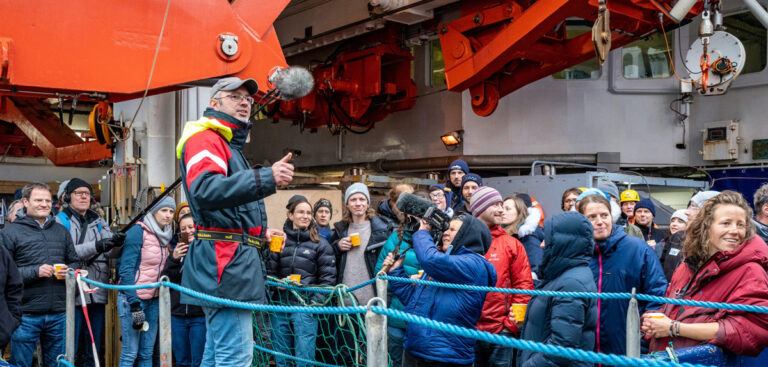After a month’s absence, on June 17 the German research icebreaker Polarstern rendezvoused with the Arctic MOSAiC floe at 82.2° North and 8.4° East, after having previously left it on May 19, 2020, to exchange personnel and bunker supplies near Svalbard.
The location of Polarstern’s return destination was never in doubt: autonomous monitoring stations transmit positioning data from the drifting floe at regular intervals. During the absence of personnel, the station continued to automatically gather data, such as energy balances (energy transfers between the atmosphere, ice and ocean) and more, ensuring that fundamental parameters could still be monitored while the researchers were away.
Prof. Markus Rex, leader of the MOSAiC expedition, an atmospheric physicist at the Alfred Wegener Institute Helmholtz Centre for Polar and Marine Research (AWI), and a professor at the University of Potsdam in Germany, gave his first impressions of the floe upon returning: “The thickest area of the floe, which we dubbed the fortress, has for the most part weathered the deformations in the spring quite well, and continues to offer a good basis for our research camp.
“We’ll be able to continue working here well into the summer,” he continued. “But, with the extensive summertime melting that has already begun, we’ll need to keep our instruments and installations highly mobile, and be ready to adapt to changing circumstances. Later in the summer, it may be necessary to relocate the camp – it all depends on how the ice conditions develop.”
Navigating and maneuvering the Polarstern to the floe was not the work of a moment, explained Capt. Thomas Wunderlich, responsible for the operation: “What’s most important, just as it was back in the days of the early explorers, is to not just charge in, but to find the ideal position for entering the ice. For the first few days, we made good and rapid progress, thanks to the prevailing winds and good visibility.”
But from 82° North, he said the situation grew “tenser”, the ice dynamic increased and the ice grew thicker. “As a result, on the weekend of June 13/14, the pack ice slowed us to a standstill, forcing us to shut down the engines to conserve fuel,” he continued. “But coming to a dead stop like this also has the advantage of showing you that nothing about this venture is predictable or can be taken for granted – sometimes you just have to accept your circumstances.”
Highlighting the importance of the project, Rex explained, “In the summer that’s just now beginning, we’ll investigate the processes at work in the Arctic climate during the melting season in unprecedented detail.” This work will include looking at ocean eddies, which are produced below the ice by ocean currents, how the thickness and properties of sea ice influence climate processes, the role of snow cover on sea ice, the nature of the interplay between the sea ice as well as atmospheric and cloud studies.
On this final subject, summertime melting has now begun, producing pools on the surface of the sea ice that alter its energy budget. When the ice ultimately breaks, the resultant leads and channels release water vapor and aerosols, which lead to cloud formation in the atmosphere. What the characteristics of these clouds are, and whether they cool or warm the lower atmospheric layers, are some of the other questions that the research team will explore before the Polarstern departs for her homeport in Bremerhaven, where the icebreaker is expected to arrive on October 12.



